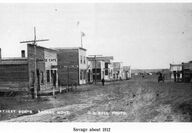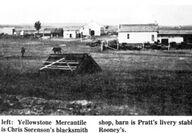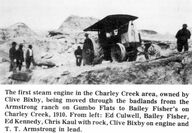Sorted by date Results 51 - 62 of 62
The Girard Post Office originated in about 1907 and was located on the William Pinkly farm, about one-half mile north and quarter of a mile west of the present Raymond Franz farm. Mrs. Pinkly was the first postmistress. The post office took its name from Girard Butte which was about two miles southwest of the Pinkly farm. The story goes that the butte was named after Girard Whistler, an army officer of Fort Buford. In the spring of 1928, Ruby Daniels, was appointed postmistress. At that time the post office and store were relocated in a small...

Girard Hall is one of the few remaining community halls in Richland County still in use. Located 17 miles west of Fairview on Highway 201, the hall will celebrate it's centennial this year with a community dance in September. The Girard Hall Association maintains the hall and activities include dances, showers, meetings, funeral lunches and more. From Courage Enough: The fall of 1913 and early 1914 a group of homesteaders held a few meetings at different homes to make plans for a new community...

In the fall of 1909 an influx of people came to the Fox Lake area to homestead on government land. Some frame houses were built as early as 1909. Leo Prevost came here from Quebec, Canada in 1911 and built a four-room house two miles east of Lambert. The Cummings home was the first house which consisted of two stories, with one room on each floor. The post office of Fox Lake was established in 1911 in the home of L.C. Cummings. Mrs. L.C. Cummings was instrumental in opening the first school...

A railroad man from Billings, Montana by the name of Savage came down the valley and spotted a bit of prairie which he thought was an ideal spot for a town. He may have been Patrick B. Savage who proved up on a homestead in Section 20, Township 27, Range 56 on April 21, 1913. He bought the land and the town started March 3, 1910. Homesteaders were rapidly settling the area. The main canal was completed in 1909 and water turned on in 1910. Emma Jeffries was the first telephone operator. She owned...
More settlers were coming in and people realized that a school was needed. There was a German man by the name of Henry Elm in the community who was instrumental in the founding of many of the school districts. He had belonged to German nobility but because of a birthmark on his face, his family was ashamed of him and thought it was a disgrace to have him around. This sent him to school away from home as much as they could. This was an advantage to him as he got a good education. He left home and went to South America where he decided to raise...
Sears was a small town located east of the stage road about one-half mile and north of Sears Creek. The present highway follows the old stage road. The town was located on the site of the home of the late Fred Peterson. Sears grew fast and died fast when the railroad went through approximately one-half mile east and below the hill. The first train went through to Sidney in 1912. The Sears Schoolhouse was cut in two and upper floor was moved about one and one-half miles south where the main road intersected the railroad tracks. It was graded...
Manrock too, had visions in those early days. It was originally platted in four blocks but abandoned in 1963. It lies a few miles west of Lane and was named after odd rock formations nearby....
Our community which is now Mount Pleasant, had its first people set foot on it in 1891. The first settlers were Pete Quilling, Ralph Blair, Ally McChesney, Frank Delamore and Frank Young. Pete Quilling was the first to plow the land. In the years 1921 more settlers moved in and by this time there were enough children for a school. The first school was held in Ally McChesney’s house for three months. The building that Mr. McChesney was going to tear down was moved to an acre of land that Sarah McChesney sold for 60 dollars. The sight for the s...
The Great Northern Railroad, Richey Branch, reached as far as the small community of Lane in 1916. Mrs. Thompson Kemmis was the first postmistress. There was a general store, restaurant, mechanic shop, and elevators. The townsite consisted of eight blocks and was not abandoned until 1963....

When the railroad was started in 1910 it missed some of the small towns. One of these was Sears, which was located about halfway between Crane and Savage. The railroad missed this town by about a mile, so Crane and Savage were started. The business places moved both ways. Some larger concerns started places in both towns. The first church was built in 1914. It was a basement church. The new church was built in 1928....

If you look at an old map of the Richland County area, you'll find a creek called the Elk Horn Creek but if you look at a present day map of the same area, that creek is called Charley Creek. The first school in this section of the county was in 1902, District 17 on the Gumbo Flats. The first 4-H club "The Charley Creek Jolly Bunch" was organized on the creek in 1927....

In June, 1884 a petition was signed by G.F. Grant, E. Dunlap and others and presented by J.H. Ray, county superintendent, to the Dawson County Commissioners which created School District Seven, a large school district with its center at Tokna. The district boundary began at a point where Range 57 East crosses the Yellowstone River at Burns, thence in a northwesterly direction to the Indian reservation (now no more), east to the Newlon School District Four and followed the district line south...